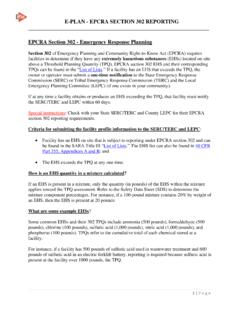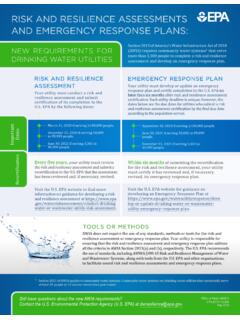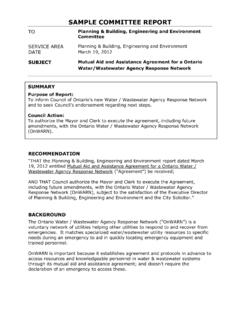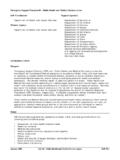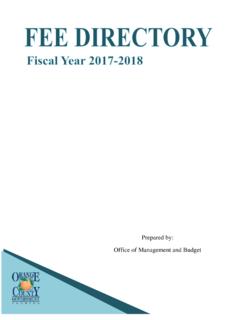Transcription of Wastewater Emergency Response Plan Template Instructions
1 EPA Office of Water (4608T) EPA 817-B-21-003 July 2021 Wastewater Utility Emergency Response plan Template and Instructions Wastewater Utility Emergency Response plan Template and Instructions Introduction This Template assists Wastewater utilities with developing an Emergency Response plan (ERP). An ERP describes your utility s strategies, resources, plans, and procedures to prepare for and respond to an incident, natural or man-made, that threatens life, property, or the environment. Incidents can range from small main breaks or localized flooding to large scale hurricanes, earthquakes, or system contamination, among other examples. When an incident occurs that requires Response , you will need to activate the procedures and protocols described in your ERP. This can include implementing personnel Emergency roles and responsibilities, activating your utility s Incident Command System (ICS) organization, recalling personnel on vacations, and notifying external agencies such as your local Emergency management agency, police, fire department, and state regulatory agency.
2 As you respond to an incident, you should immediately begin documenting your decisions, actions, and expenditures. This step is important for justifying incident costs and potentially seeking reimbursement once the incident is resolved. Good incident documentation involves creating a paper trail for receipts, records, photographs, and personnel timesheets. Access both the Federal Emergency Management Agency (FEMA) Public Assistance Program and EPA s Fed FUNDS websites for guidance on documenting incident costs. How to Use this Template Use this Template as a starting point in building an ERP. Since each Wastewater utility has unique challenges in managing and operating its incident Response , you may want to include additional sections, appendices, or references to external information tailored to your utility s needs ( , including Incident Specific Response Procedures with large Wastewater dischargers for a pretreatment failure, an appendix containing safety procedures related to water quality sampling by boat).
3 You may also use a completely different format, such as a state regulatory agency or Wastewater association Template . If you already have an ERP, use the Template Table of Contents as a checklist to see if you are missing any items in your ERP. Before you begin, save the ERP Template to your computer, delete the EPA cover page from the Template and consider the following steps to help gather the key information to develop your ERP: 1. Conduct a risk assessment (RA): the findings identified in your RA will enhance the effectiveness of your ERP. For example, your RA may identify hurricanes as a significant risk for your utility and outline cost-effective countermeasures to lower your risk. Your ERP, grounded in the results of the RA, then describes the processes and procedures that can be implemented to mitigate hurricane impacts ( , flooding) to your utility. see EPA s Vulnerability Self-Assessment Tool for more information on conducting an assessment.
4 2. Identify regulatory requirements: states may have regulatory requirements for ERP content and may also provide templates. C heck with your state primacy agency for further information. 3. Identify other plans: your ERP should dovetail with other Emergency plans in your community ( , county Emergency operations plan ) as much as possible. 4. Coordinate with Response partners: teaming with partners and stakeholders ( , local government, local community organizations, other utilities) allows all parties to understand the proper Response processes and procedures used during a Wastewater incident. 5. plan for resources: the resources your utility owns or has access to ( , personnel, equipment, supplies, and facilities) will influence how you develop your ERP procedures. You will need to develop strategies to obtain needed resources that you do not own or that are not readily available in your community.
5 Wastewater ERP Template Wastewater Utility Emergency Response plan Template and Instructions Since an ERP may contain sensitive information, make sure to store it in a safe and secure location. Consider storing one copy on-site and one off-site in case you are unable to access your offices or facilities during an incident. You may also wish to store an electronic copy on a shared drive or other digital platform easily accessible by your utility personnel. Similarly, up-to-date plans and schematics of your treatment plant and collection system ( , location of chemical rooms, lift stations), as well as up-to-date operations manuals could be kept in at least two secure locations, preferably one being with the final version of the ERP or referenced where to find them. Your ERP should be viewed as a living and evolving document with established maintenance guidelines for routine and non-routine updates, the circumstances under which the updates will occur, and the personnel or departments responsible for the updates.
6 For example, you should conduct an incident debrief or after-action conference immediately fol lowing any ERP activation to review and discuss what worked well and what areas of the ERP may need improvement. Assign someone the responsibility to make modifications or additions to the ERP based on your discussions. Lastly, once your ERP is complete, consider training your utility personnel and Response partners on its contents and their individual roles and responsibilities. Conducting periodic trainings for both senior and new personnel helps to ensure that your ERP procedures will be effectively implemented during an actual Response . Tabletop exercises are an effective means to practice and test your Response procedures access EPA s Tabletop Exercise Tool website to learn how. Wastewater Utility Emergency Response plan Template and Instructions TABLE OF CONTENTS 1 UTILITY INFORMATION .. 1 Utility Overview.
7 1 Personnel Information .. 1 Utility Components .. 1 Industry Chemical Handling and Storage Facilities .. 1 1 Response Resources .. 1 Key Local Services .. 2 2 RESILIENCE STRATEGIES .. 2 Emergency Response Roles .. 2 Incident Command System (ICS) Roles .. 3 Communication .. 3 Internal Communication .. 3 External Response Partner Communication .. 3 Communication with Critical Customers .. 4 Communication Equipment Inventory .. 4 Media Outreach and Risk Communication .. 4 Public Notification Templates .. 4 3 Emergency PLANS AND PROCEDURES .. 4 Core Response Procedures .. 4 Incident-Specific Response Procedures .. 6 4 MITIGATION ACTIONS .. 6 Storage and Treatment Mitigation Actions .. 7 Other Mitigation Actions .. 7 5 DETECTION STRATEGIES .. 7 Unauthorized Entry into Utility Facilities .. 7 Wastewater Contamination .. 8 Cyber Intrusion.
8 8 Hazardous Chemical Release .. 8 Natural Hazards .. 8 Power Outages .. 8 APPENDIX: PRACTICAL MITIGATION OPTIONS FOR UTILITIES .. 9 Page 1 | Wastewater Utility Emergency Response plan Template Instructions 1 UTILITY INFORMATION During an incident, you need to have system information about your Wastewater utility readily available for your personnel, first responders, repair contractors/vendors, the media, and other Response partner agencies. Utility Overview Provide basic information about your utility in the table in this section. The information required here should be readily available. You may also choose to provide additional detailed information about your utility, such as collection system maps, plan drawings, site plans, lift station locations, and operations manuals. This information may serve as orientation materials for Response partners and others who may not be familiar with your utility.
9 You can use the checklist in this portion of the ERP Template to ensure that applicable and relevant documents, as appropriate, are included or referenced as a part of your ERP. Personnel Information It is important to have a personnel roster available during an incident, so you can quickly contact your employees. Attach your staff roster or fill out the table provided in this section. Utility Components In the tables provided, list as appropriate all the components necessary to maintain effective operation of your utility. This includes information on your collection system, treatment plant(s), onsite and offsite treatment chemical storage, lift station(s), outfall(s) and other key facilities as appropriate. If you use an asset management system, you may simply generate a list of your primary components and insert that list into this section. See EPA s Asset Management website for more information.
10 Industry Chemical Handling and Storage Facilities Industry surrounding your utility can also be impacted by incidents such as accidental releases, wildfires, hurricanes, floods, or earthquakes. It is important that you understand what chemicals may be released in your area during an incident and how they may impact your utility operations. As you complete the tables in this section, you should consult your Local Emergency Planning Committee (LEPC), which will know the locations of Tier II chemical handling and storage facilities in your area. You may also refer to online planning tools, such as EPA s Drinking Water Mapping Application (DWMAPS) website, to help you locate potential sources of contamination in your area. Safety Having easy access to safety materials and important safety information and procedures will help protect utility personnel during an incident. You can use the tables in this section of the ERP Template to record that information, or, if your utility has a Health and Safety plan , you can simply reference that in this section.










